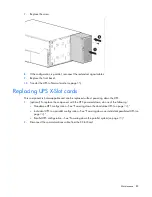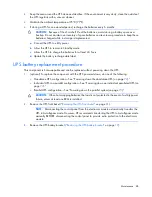
Communication 77
The UPS incorporates a programmable relay output with potential free contacts for remote alarm indications.
An additional four relay outputs can be obtained with the compatible Relay Interface option card.
Programmable signal inputs
The UPS incorporates two programmable signal inputs. HP recommends using non-polar (relay) control input.
The pins must be shorted with maximum resistance of 10 ohm in order to activate the specific input.
Verify control terminal connections if polarity control is required.
Signal
Description
empty
Not in use (default)
building alarm 1-2
These alarms can be activated separately or at the same time with other building
alarms.
Building alarms are local only to the UPS.
on generator
If active, the High Efficiency setting is disabled (BladeUPS 12i model only) and
battery tests are disabled.
1
ext battery breaker
If active, the UPS knows that the external batteries are disconnected.
2
request bypass
If active, the UPS transfers the load to bypass when the bypass voltage,
frequency, and phase rotation are within the allowed limits.
1
force bypass
If active, the UPS is forced to static bypass operation regardless of the bypass
status.
1
on/OFF
If active, the UPS output powers down regardless of the mode of operation.
Auxiliary power, communication, and rectifier/battery charger remain
functional. Restart is initiated immediately when the signal is inactive.
2
charger off
If active, the battery charge function is disabled. In a utility power outage, the
discharge of batteries is supported.
2
1
Program for only one UPS in a parallel system.
2
Program for all UPSs in a parallel system.
Use the programmable signal inputs to emulate some of the features usually seen on larger 3-phase systems.
For example:
•
Configure the signal from a smoke detector or water leak detector to power down the system.
•
Configure a vibration sensor or air conditioner sensor to power down the system.
•
Set actions for alarms from a generator, such a disabling the charger for an undersized generator or
shutdown for a failed generator.
•
Configure an ATS sensor to transfer the system to Auto-Bypass mode.
Parallel communication
The Parallel UPS Card in each paralleled UPS provides connectivity for system metering and operational
mode control. Powering up, powering down, and auto-calibration commands given at one UPS also
command the other UPSs in the parallel system. The UPSs in a parallel system are in constant communication
to monitor settings and status information.
















































